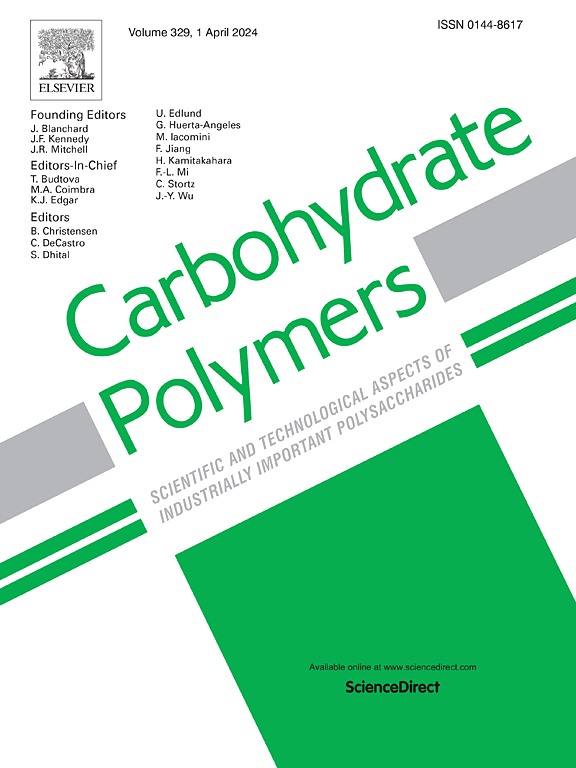聚合物诱导发光手性向列相纤维素纳米晶体材料的荧光增强效应
IF 10.7
1区 化学
Q1 CHEMISTRY, APPLIED
引用次数: 0
摘要
从嵌入在手性矩阵的荧光团中产生的强而定制的圆偏振发光(CPL)在光子技术中引起了极大的兴趣。然而,由于分子聚集导致的荧光猝灭发生在高荧光团负载的固态中。在这里,我们提出了一种简单的聚合物诱导荧光增强策略来制造由纤维素纳米晶体(CNC)和罗丹明6G (Rh6G)组成的坚固发光薄膜。发现聚合物的类型、分子量和浓度在调节薄膜荧光中起关键作用。结果表明,聚合物通过屏蔽Rh6G分子与CNC-Rh6G之间的相互作用,有效地迁移了荧光猝灭,导致荧光猝灭的显著增强高达47倍。CNCs的左手手性向列结构可以将Rh6G发射转化为可控制的左手或右手CPL。通过调整复合膜的聚乙二醇浓度和光子带隙,可以获得具有可调的手性、强度和波长的CPL,其不对称因子在−0.35 ~ 0.14之间。这种聚合物诱导的荧光增强和可调谐CPL突出了基于cnc的发光膜作为先进功能材料的潜力。本文章由计算机程序翻译,如有差异,请以英文原文为准。

Polymer induced fluorescence enhancement effect on luminescent chiral nematic cellulose nanocrystal based materials
Strong and tailored circularly polarized luminescence (CPL) from fluorophores embedded in chiral matrices has gained significant interest in photonic technologies. However, fluorescence quenching due to molecule aggregation occurs in the solid state at high fluorophore loading. Here, we present a simple polymer induced fluorescence enhancement strategy to fabricate robust luminescent films composed of cellulose nanocrystal (CNC) and rhodamine 6G (Rh6G). The type, molecule weight, and concentration of the polymer are found to play critical roles in modulating film fluorescence. The results demonstrate that polymer effectively migrates fluorescence quenching by shielding interactions between Rh6G molecules and CNC-Rh6G, leading to a remarkable enhancement of up to 47 times. The left-handed chiral nematic structure of CNCs can transform the Rh6G emission into controllable left or right-handed CPL. By adjusting the polyethylene glycol concentration and photonic band gap of composite films, CPL with tunable handedness, intensity, and wavelength are achieved, yielding a dissymmetric factor ranging from −0.35 to 0.14. This polymer induced fluorescence enhancement and tunable CPL highlight the potential of CNC-based luminescent films for advanced functional materials.
求助全文
通过发布文献求助,成功后即可免费获取论文全文。
去求助
来源期刊

Carbohydrate Polymers
化学-高分子科学
CiteScore
22.40
自引率
8.00%
发文量
1286
审稿时长
47 days
期刊介绍:
Carbohydrate Polymers stands as a prominent journal in the glycoscience field, dedicated to exploring and harnessing the potential of polysaccharides with applications spanning bioenergy, bioplastics, biomaterials, biorefining, chemistry, drug delivery, food, health, nanotechnology, packaging, paper, pharmaceuticals, medicine, oil recovery, textiles, tissue engineering, wood, and various aspects of glycoscience.
The journal emphasizes the central role of well-characterized carbohydrate polymers, highlighting their significance as the primary focus rather than a peripheral topic. Each paper must prominently feature at least one named carbohydrate polymer, evident in both citation and title, with a commitment to innovative research that advances scientific knowledge.
 求助内容:
求助内容: 应助结果提醒方式:
应助结果提醒方式:


